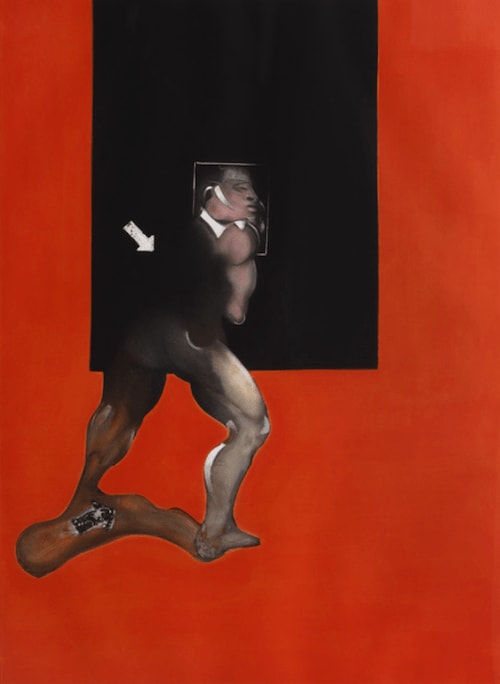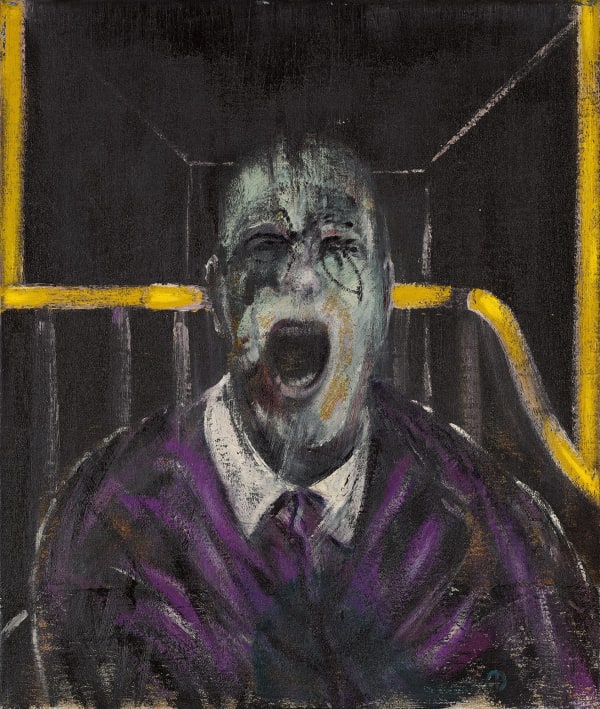-
Francis Bacon Prints For Sale.
Francis Bacon's art is a deep exploration of the human condition told through the revolutionary lens of a true genius. His distorted and contorted figures explore aspects religion, mythology & the deeply personal. Explore our latest Francis Bacon prints for sale at Guy Hepner, Bacon dealers since 2007.
Discover authentic Francis Bacon signed prints for sale below.
-
Works

Francis Bacon
Study from Human Body , after Study from Human Body 1987, 1992Aquatint on Fabiano paper64 1/8 x 47 5/8 in
163 x 121 cmEdition of 90 plus 30 APCopyright The ArtistFrancis Bacon’s After Study from the Human Body is a powerful embodiment of the artist’s radical reimagining of the human figure—an image defined not by anatomical precision, but by distortion,...Francis Bacon’s After Study from the Human Body is a powerful embodiment of the artist’s radical reimagining of the human figure—an image defined not by anatomical precision, but by distortion, fragmentation, and existential exposure. As with much of Bacon’s work, this piece reflects his relentless interrogation of the body as a vessel of vulnerability, a site where physical form collides with psychological unrest. In this print, Bacon intensifies the viewer’s experience of bodily disintegration and inner tension, situating the figure in a stark, abstracted space that denies comfort or familiarity.
The central figure in After Study from the Human Body is twisted and deformed, its proportions stretched and distorted to the point of abstraction. Most notably, the legs—contorted and exaggerated—seem to fuse with the ground beneath them, blurring the boundary between flesh and floor. This gesture renders the body unstable, neither fully upright nor grounded, and evokes a powerful sense of dislocation. The figure appears trapped in a state of metamorphosis, as though it is being absorbed by its surroundings, or melting into the very surface upon which it stands. Bacon’s figures are rarely static; they pulse with tension, caught mid-motion in some unseen struggle, often embodying a liminal space between coherence and collapse.
This sense of entrapment is reinforced by the composition’s striking visual architecture. A bold, flat expanse of orange dominates the background, engulfing the scene in an unnatural, emotionally charged atmosphere. The orange is both vibrant and unsettling—a color that does not soothe but sears, functioning almost like a psychological heat map. Against this backdrop, the figure is rendered in dark, bruised tones, further isolating it within the frame. A black rectangle—functioning as a spatial enclosure or framing device—surrounds the body, heightening the claustrophobic effect. It is as though the figure is boxed in by its own existence, symbolically confined within the limits of flesh, mortality, and self-awareness.
Bacon’s refusal to place his subjects in recognisable, grounded environments is central to his strategy. The space in this work is not realistic, but existential. There is no horizon, no depth, no relief—only flatness and void. The environment acts as a psychological pressure chamber, directing all attention to the battered form at its center. The body is not heroic, idealised, or even whole. It is raw and ruptured, its deformation speaking as much to inner turmoil as to physical instability.
More than anatomical representations, Bacon’s figures are psychological portraits. The distortions he applies to the body are metaphors for emotional rupture—for the tension between interior experience and external form. In After Study from the Human Body, the figure’s posture, ambiguity, and almost animalistic form evoke a state of crisis—perhaps anguish, perhaps defeat. There is no face to read, no identity to anchor; the figure is depersonalized, universalized. It becomes an archetype of existential fragility, representing the human being stripped of social veneer and exposed to the raw conditions of existence.
The emotional impact of the work is heightened by its minimalism. With so little visual information—no narrative cues, no landscape, no symbolic props—every compositional element becomes charged with meaning. The enclosure, the aggressive color, the ambiguous anatomy—all work together to create a space where the viewer is forced to confront not only the fragility of the body but the instability of identity itself. Bacon’s refusal to offer resolution or coherence mirrors the dissonance of modern life, where meaning is elusive and the self is fragmented.
At its core, After Study from the Human Body is a meditation on the violence of being—the tension between the physical shell and the chaotic interior, between visibility and erasure. It is a continuation of Bacon’s broader philosophical engagement with the works of existentialist thinkers such as Nietzsche, Sartre, and Beckett, whose writings explored the absurdity of existence, the void of meaning, and the disintegrating structures of identity. Bacon does not offer solace; he offers truth—distorted, unvarnished, and hauntingly immediate.
In this work, as in much of his output, Bacon redefines what it means to depict the human form. He moves beyond the body as a physical object and into the body as an emotional and psychological condition. After Study from the Human Body is not just a study in flesh, but a study in being—where the form is both presence and disappearance, resilience and collapse, exposure and entrapment. It is a testament to Bacon’s unique ability to express the inexpressible, to make visible the invisible fractures of human experience.
For more information on Francis Bacon’s After Study from the Human Body or to buy Francis Bacon’s After Study from the Human Body contact our galleries using the form below.18of 18Overview"The job of the artist is always to deepen the mystery".
Francis Bacon is one of the most important artists of the 20th century and post-war movements. Arguably one of the finest and most celebrated artists of his generation, Bacon holds a pivotal role in contemporary art through his revolutionary approach to his craft. One of the great explorers of the human condition Francis Bacon and his art, touch on fateful mix of mythology, religion, love and death, and document our joys, sorrows and pains perhaps better than any other artist before or since.
The imagery of Bacon is one of pure expression rejecting the prevailing artistic style of abstraction of the era, in favor of a distinctive and disturbing realism and his distorted forms convey a sense of both beauty and despair. The dichotomy in Bacon’s prints and imagery can be seen through his raw use of violent, yet delicate colors as well as the marriage he makes between the figurative and abstract. It is this soft balance between the brutal and the subtle, the violent and the soft and happiness and anguish that make Francis Bacon’s art so important and collectible. A master of painting, and known for his large scale canvases, Bacon combines seemingly disparate tectures, colours and forms to ceate a whirlwind of emotion conveying and reaching the heart of his subjective matter. Equally so Franci Bacon's print output, often as apres, lithographs or signed prints, offer his most popular subjects including Pope Francis and his famous triptychs.
Whether new to collecting Francis Bacon prints or an experienced collector, Guy Hepner can help. Since 2007 we have assisted clients across the world to buy Francis Bacon prints in confidence. Whether iconic triptych, lithographs or apres, our experienced and knowledgeable team are on hand to help you achieve your collecting goals. From our New York and London galleries, offer a wide selection of authentic Francis Bacon prints for sale.
Contact info@guyhepner.com for our latest Francis Bacon prints for sale or to buy Francis Bacon original art. News
News-

London’s Frieze Week Record Breakers
A Guide to a Blockbuster Week of Sales October 20, 2025London’s marquee auction houses just concluded a blockbuster week of contemporary art sales, coinciding with the Frieze art fair. In a series of evening auctions...Read more -

A Collector’s Guide to Francis Bacon Prints
Why Collect Bacon March 14, 2025Francis Bacon remains one of the most powerful and influential artists of the 20th century. His raw, visceral works depicting the human form in distorted,...Read more




